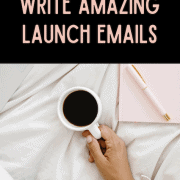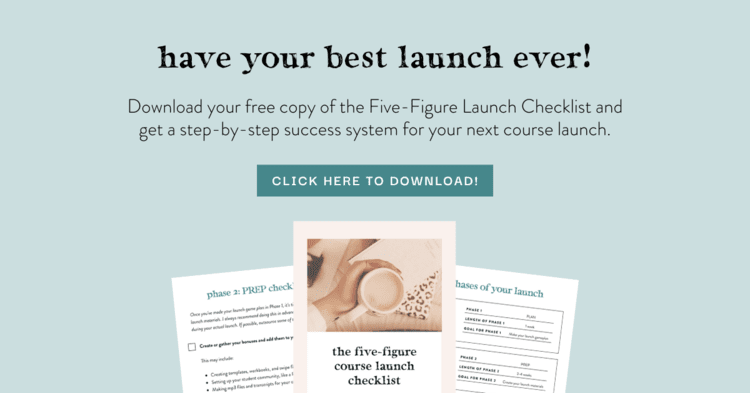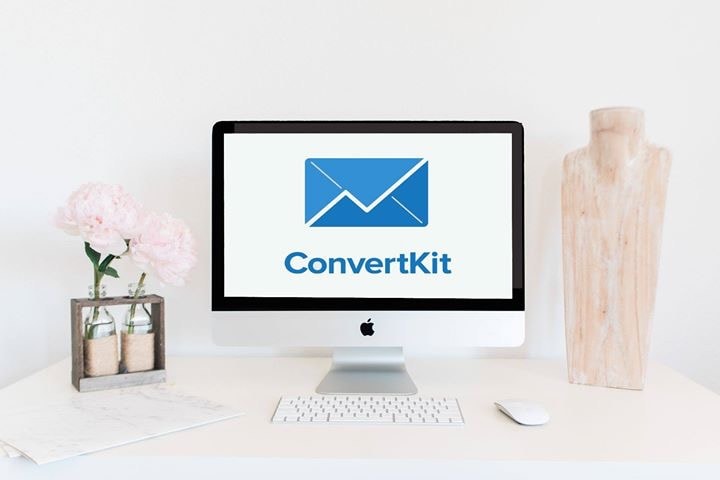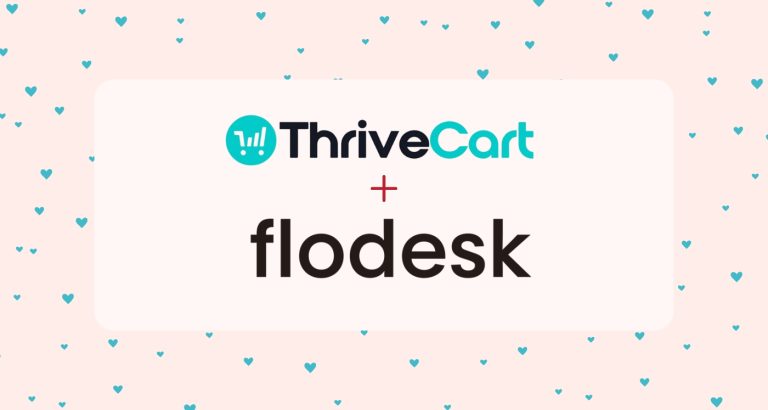How To Write Amazing Launch Emails That Convert

Are you ready to learn exactly how to write amazing launch emails?
When you’re launching an online course, email marketing is one of the most important things to focus on! Creating incredible launch emails is essential to converting more of your leads and generating more sales for your course.
As an affiliate partner of various brands and sponsored content, HerPaperRoute may earn commission on qualifying purchases. Disclaimer
Maybe you’ve never really dabbled with writing launch emails. Sometimes, we write one email and don’t see results, so we don’t write anymore. Other times, we get overwhelmed trying to find inspiration and figure out what emails we even need to create.
But whenever you’re ready to start writing launch emails, these tips will help you do it with less stress and way better results!

How To Write Amazing Launch Emails That Convert Every Time
There are so many things to keep in mind when you’re writing launch emails—and this post is going to cover all the bases!
First, you’ll learn how to avoid “boring robot syndrome,” and how to keep your emails engaging and fun for people to read. This will help boost your open rates and your click rates!
We’re also going to talk about the importance of direct response copywriting.
If you don’t know what that is, don’t worry. Basically, it’s just the type of writing that you need to know how to do if you want to generate sales.
Then finally, we will dive into the launch email breakdown. I’ll share the top five emails that I recommend sending to your list during your launch and exactly what to include in each of those emails.
Let’s dive in and create a playbook you can use to knock your launch emails out of the park every single time!
Focus On Growing Your Email List Before Your Course Launch
Before you actually launch your course, your priority should be growing your email list.
But how do you actually do that?
You should create a lead magnet or opt-in freebie that you’ll release during your pre-launch phase, a set amount of time before you launch your course. This freebie should be directly related to the content or topic of your course.
Your lead magnet could be some kind of free roadmap, PDF checklist, workbooks, or anything enticing that’s related to the topic of your course.
You’re going to release that freebie to the world during your pre-launch phase.
That freebie is going to attract those relevant, hot leads to your email list. Then, when you launch your course, you have people on your list who are most likely going to be interested in your course.
Start Nurturing Your Email Subscribers Before It’s Time To Send Launch Emails
The pre-launch work doesn’t end with growing your list, though! Once you’ve created your lead magnet, it’s also really important to continue to warm up new and existing subscribers with relevant and valuable content before your course launch.
I recommend emailing your list once a week (at a minimum) during the pre-launch.
Send out really relevant, helpful content that builds that “know, like, trust” factor with your subscribers.
Then you’ll be ready to launch successfully with a list that’s primed for what you have to say!
Related: How to Write an Epic Welcome Series in the Next 7 Days
Planning Your Launch And What Launch Emails To Send
Next, it’s time to create a launch calendar!
You can print out a physical calendar or do it digitally. Write down every single thing that’s going to be happening during your launch.
On your launch calendar, write down things like:
-
Cart open date
-
Cart close date
-
Timing of any time-sensitive bonuses you’re offering
-
When any price changes are happening
-
Launch emails and when they’ll be sent
-
Social media topics, strategies, and post dates/times
Make sure that you create a launch calendar well in advance of your launch. It will make the entire launch process so much smoother, and you’ll feel so much more organized.
On a similar note, I highly recommend writing your launch emails ahead of time if possible.
Write your launch emails in advance and leave room to make changes or tweak them as needed during the actual launch itself.
Writing your launch emails ahead of time allows you to see and feel the overall flow of your launch email sequence.
Rather than just looking at one email at a time by writing them in real-time, when you have the entire sequence in advance, you can really see how they flow together and how everything works together.
You’ll be able to see if anything’s missing, repetitive, or not super engaging.
You’ll also feel way less stressed during your launch when your emails are ready to go.
How To Structure and Style Your Launch Emails
How should you style and structure your launch emails? While this might not feel that important, the style and structure truly matter.
The easier your emails are to read, the more people will actually read them! That means they need to be interesting to look at. People hate huge paragraphs of text without font changes, headings, and white space.
Here are my best tips for styling and structuring your launch emails.
Use Bullet Points
Bullet points are incredible, especially for reading things on the internet or on our phones. They allow you to break up important information and make it easier for people to read.
Add Images
Don’t go overboard with images, but in a few of your launch emails, strategically adding images goes a long way!
Style The Text Of Your Emails
Make sure you style the actual text of your emails. It should not just all be plain text.
Bold important bits of texts, use italics here and there and add headings to keep things organized and skimmable.
How To Increase The Open Rate Of Your Launch Emails
Let’s talk about how to actually get people to open your launch emails.
To boost your open rate, you need to focus on writing the best subject lines possible. When it comes to your launch emails, consider A/B testing your subject lines.
To do an A/B test, send one version of your email to one segment of your email list with subject line A, and then send the exact same email to another segment, but with subject line B.
You’ll see which subject line performs better, and use that one in your actual launch emails.
This might sound a little confusing, but your email marketing platform likely will do it for you. I use ConvertKit, and they’ll literally handle all aspects of the A/B test for you—all you need to do is plug in the subject lines.
ConvertKit even automatically sends the “winning” subject line email to the rest of your list a few hours later!
When you’re coming up with your subject lines, always think about the person on the receiving end.
Your subject lines are all about enticing the subscriber to open your email and take action. A great subject line incentivizes people to open the email and see what’s inside.
Here are even more tips for writing great subject lines for your launch emails.
7 Tips For Writing Your Launch Emails
Before we dive into the five types of launch emails you should be sending, here are some tips to help you write the best emails possible.
Use Countdown Timers
Use countdown to create a sense of urgency. A timer works more effectively than just writing what time the cart closes—and it accounts for time zones!
Countdown timers automatically show the remaining time based on where that subscriber lives.
Don’t Shy Away from Using CTAs
Do not skimp out on or shy away from your calls to action.
Give a really clear and direct call to action telling people how to sign up. Tell people what link to click on, how to sign up, and how to learn more.
Infuse Your Personality & Brand Voice
Infuse your personality and your brand voice into your launch emails. You should be doing this with any email that you write, but it’s the key to making your emails more engaging.
Use your brand voice and write the email as a person, not as a brand.
If you’re struggling with voice-infused emails, try this. Write the entire email first.
Then, on the second pass-through when you’re starting to edit, add in more personality, voice, hashtags, and emojis.
Add Lots of Testimonials
Sprinkle in LOTS of testimonials throughout your launch emails. Don’t reserve them for just the sales page or for only one email—put them everywhere.
You can’t possibly go overboard. People want to see that others have made the leap, invested in your course, and gotten results.
Add formal testimonials as quotes directly from the student or casual screenshots of Facebook group posts, emails, and Instagram DMS that your students have sent you sharing their wins and talking about how excited they are.
Vary the Length of Your Emails
Play around with different lengths of emails and see what gets the best response from your audience.
Don’t Forget to Edit!
Make sure you are editing your launch emails.
Go beyond basic proofreading (but do that, too!) and learn to trim the fat. That means cutting out things that don’t need to be there.
Use Direct-Response Copywriting
My last tip for writing launch emails is to use direct response copywriting.
We want to write in a way that gets people to take a specific action right away. Be creative and remember your calls to action!
5 Types Of Launch Emails You Should Start Creating
Now that you know how to plan, strategize, set up, and write your launch emails, what types should you actually be sending out?
1. Cart Open Email
A cart open email announces that your course is now available and open for enrollment.
Introduce your course and tell us who it’s for, what big problem it solves, and the big promise for results.
Add details about what’s included. You might also include a value stack, a bullet point list of the main things that are included in your course and in your offer. This could include how many modules, videos, workbooks, PDFs, MP3 files, bonuses, etc.
Finally, if there’s any kind of scarcity or urgency to really encourage people to join the course right away, instead of waiting, you can mention that near the end of this email.
Make sure you end with a strong call to action.
2. The “Why” Email
The second email I recommend sending should focus on the “why.”
Share the story of why you created this course in the first place. Why is this course on this topic? Why is it important to your audience? Why is it important to your students?
You can even go a little deeper into your backstory.
Then cover the larger results this course will help people achieve. How are their lives going to improve? Paint a really clear picture of where your students will be six months from now, one year from now, or five years from now.
3. Case Study Or Testimonials
Your third email should include a case study and testimonials.
Include both a case study and a nice little stack of testimonials inside one single email. This lets other people talk up your course for you.
Make sure to focus on the before and after in these testimonials!
4. FAQ Email
Next, send out an FAQ email.
Give the most important details about your course and your offer in a rapid-fire way.
Most people will not read your entire sales page or every single email you send during a launch.
An FAQ is to-the-point and helps overcome potential objections that people might have about joining your course.
Write strong, direct response copy that persuades people to take the leap.
5. Cart Close Email
The last email you should send is your cart close email. Keep things short and sweet and make it all about urgency.
Include at least one countdown timer for when enrollment closes, and consider putting one at the top and bottom of your email.
Reiterate the big promise of your course, like who it’s for, what problem it solves, and what results people will achieve.
If you have included some kind of last-day bonus (which can be a really powerful incentive to get those lingering interested subscribers to convert!), talk about that in this email as well.
Whatever you do, make sure you have at least one, but probably multiple really strong, clear calls to action.
Launching a new product is an exciting time.
You’re leveling up your business and offering something awesome to the world! That’s especially true if you are sharing your skills through an online course that will empower other people.
… But it can also be a very intimidating time. A lot of entrepreneurs deal with intrusive thoughts such as “What if no one buys my course?”,
“How will I go on if my launch flops?”, and “How do I even launch well?!”
Don’t worry! There are lots of strategies you can use to get your course out there and show people it’s right for them.
Why Email Marketing?
One great strategy is a launch email sequence. I’m sure you’ve heard of welcome sequences where you send a few emails in a row to new subscribers to introduce them to your list.
Launch sequences are similar but focus on introducing your new course.
Consistently sharing your course in fun and exciting ways will increase your sales.
Your email subscribers are great people to send promotions to because they already know you from previous emails and therefore are more willing to buy from you.
I’ve got the ultimate method for creating your perfect email sequence to hype up your email subscribers for your launch so they go on to purchase your course.
Before we get into that, here are two things you need to know when creating a launch email sequence…
What You need to know…
1. Everyone’s launch sequence should be different.
There is no point in copying someone else because you, your audience, and your offer are unique.
Always keep your ideal customer in mind. Your sequence might need to be longer or shorter or cover different concerns.
Consider whether your audience already sees you as an expert in the topic your course covers. If not, you’ll need to spend more time proving your expertise.
If your course has a higher price tag, you’ll need to spend more time justifying the price and return on investment.
Identify anything that could possibly get in the way of your audience purchasing from you and deal with it in your emails.
2. The majority of your email list won’t buy.
Shoot for the stars, but also keep your expectations reasonable. Everyone’s audience is different, but it’s rare that the majority of your email subscribers buy the product you’re promoting.
There are various factors that go into making a purchase decision so don’t take individuals not buying from you personally. Implement good marketing strategies and you’ll succeed.
Now that you have those two important points in mind, let’s cover how to create a launch email sequence.
This type of sequence can be split into three main stages:
- Pre-launch emails
- Launch emails
- Post-launch emails
- I’ll take you through them one by one.
The Pre-Launch Emails
The marketing of your course starts before it’s even available to buy and the pre-launch is actually the longest part of your launch sequence. You want to build excitement — and that can start from before you’ve even announced the launch or course.
In the pre-launch emails, tell your subscribers you have something in the works, share some things you’ve learned about the topic area, and include a countdown to the course announcement.
You don’t want to draw this out too long or you’ll end up frustrating your subscribers — you’re just building some anticipation.
Next, it’s time to reveal the details. Let your subscribers know what you are offering and how they can get their hands on it.
You could reveal your new course to your email subscribers first to create a sense of exclusivity, especially if there are limited spaces available.
Then, as the release date gets closer, tell your subscribers how your course is beneficial to them in different ways. You can talk about how you have tailored the course to them, how you have built in your experience and expertise, and the transformation it provides.
Remind them how close the launch is so they are ready to purchase.
To round this stage up, the purposes of your pre-launch emails are to:
- Get subscribers ready to buy
- Build excitement and anticipation
- Share the necessary details
The Launch Emails
What your launch emails look like depends on whether you’re having an open-close launch or releasing an evergreen course.
With open-close launches, you need to get as many sales as you can before the cart closes. With evergreen launches, you don’t have that time pressure — but neither does your audience so they don’t have the same need to purchase immediately.
At the beginning of the launch stage, you should announce that your course is available to purchase and let your subscribers know how they can buy it. Every email in this section of the sequence should include a link to your sales page.
The launch emails should convince your subscribers the product is right for them, can solve their specific problem, and that they need it now.
If you have a cart close date, keep reminding your subscribers when the course will no longer be available.
Exclusivity is a powerful tool, but don’t use it just for the sake of it.
Be honest with your audience. Don’t say a product is exclusive then make it available again a week later.
If your subscribers don’t trust your claims of exclusivity, they won’t have any effect.
If your launch is evergreen, you can create exclusivity in other ways. You could have a limited-time discount or an extra bonus for early bird customers.
For example, the first 10 customers, or customers who purchase within 48 hours of the launch starting.
You should have done a lot of convincing before the launch, so don’t send long emails here. Send short, snappy ones with a clear purpose.
To recap, the purposes of your launch emails are to:
- Send subscribers to your sales page
- Highlight the benefits of the course
- Make subscribers comfortable with purchasing
The Post-Launch Emails
Don’t go quiet once your audience has purchased from you! Validate their purchase by sending them a ‘thank you email’ that also gets them excited about their next steps. You want them to feel good about buying from you.
After a reasonable time, you can also check in with your new students and ask if they need any help or have feedback for you.
That’s a great way to get testimonials to share on your sales page.
Evergreen courses are always on sale, but you won’t talk about them in the same way or at the same frequency as the first few weeks of the launch. You don’t want to overwhelm your subscribers.
Instead, bring the course up when talking about other things. For example, if you’re writing an email about a related topic, you could direct subscribers towards your course to help them out.
You can talk about the success of your launch and the feedback you have been given to mention your course in a less intense way, and even include your course in your welcome sequence so that those new to you have a good understanding of what you offer.
To summarize, the purposes of your post-launch emails are to:
- Make customers feel good about buying your course
- Gain feedback to use as testimonials
- Remind your email list of evergreen offers
- Pacing Your Emails
Most email marketers contact their list at least once a week, if not a couple of times. The exception to this is during the welcome sequence when emailing is more frequent.
We can also make an exception for launch sequences. Start off at your regular emailing rate, then ramp up the emails as the launch gets closer.
Coming up to launch day, it’s fine if you are emailing very close together. If you’re doing an open-close launch, you’ll need to regularly check in with your subscribers to remind them of when the cart is closing.
Do make sure you are not causing email fatigue.
Keep in mind the number one reason people unsubscribe from email marketing is that they are being emailed too often!
Only email daily or every other day for up to about a week running up to and during the launch. These emails should be much shorter so you aren’t drowning readers in information.
That means if you are doing an evergreen launch, after the launch day you need to slow down your emails.
Start to integrate your new course into other emails by mentioning it within the email instead of making it the whole subject.
If you’re not sure what the right pace for you is, keep an eye on your open rates.
Overwhelmed subscribers will not open your emails. What’s essential is that there is a purpose behind every email. Unless it provides value in some way, don’t send it.
Sending emails for the sake of it is counterproductive.
What does this look like in practice? Here’s an example of an evergreen launch email sequence that is 10 emails long.
Example Launch Email Sequence
1. What’s new with me
Inform subscribers about developments in your business and sneak in a mention of a new course coming. You could even reveal what topic area it relates to.
2. What I have learned about [topic area]
Share some information about the topic your course relates to. This proves your expertise and gives you a chance to mention your upcoming announcement.
3. What are you doing on [announcement date]?
Prepare subscribers for the date when you will announce the new course to get them excited. This is also a good time to talk about why you are releasing the course in the first place. How will it help them? What’s your inspiration?
4. [Course name] announcement
Share what you are releasing, when, and why your subscribers should be excited about it.
5. Mistakes you are making in [topic area]
Talk about mistakes you see people making and then how your course will help them to overcome those mistakes. Use personal anecdotes or case studies if you can.
6. How to level up in [topic area]
Share how your subscribers can be the best in the topic your course is about and how your course will help them. Once again, real stories are the most impactful.
7. [Course name] is available now!
Break down what the course is, what’s included, and how it can be purchased.
8. Is [course name] for you?
Explain how the course suits your audience and solves the problem they have.
9. [Course name] FAQ
Deal with any objections to purchasing.
10. Thank you!
Confirm their purchase, thank them for supporting you, and let them know what will happen next as well as what to do if they have any problems.
Ready to write your emails?!
If you want more ideas of what your launch sequence could look like, check out this freebie that has four more email sequences alongside the one above.
It includes examples of an open-close cart sequence, a sequence to prove your expertise, a sequence to justify a high price tag, and a bare minimum sequence if you’re in a rush.
Releasing a new course is an amazing time for your business and you should be super proud of yourself for taking this step.
How To Write Epic Launch Emails – Conclusion
We made it to the end! You now have the ultimate playbook for creating incredible launch emails that convert every single time.
You’re going to love the impact that a series of launch emails makes on your future launches.
Email marketing is a great strategy for priming your audience to buy.
Get the most out of your hard work developing a new course by building as much interest as possible.
With awesome email marketing techniques in place, your launch is going to be amazing!
Want to learn more about how to make your launch a success? You should enroll in Sales Funnel Solved.
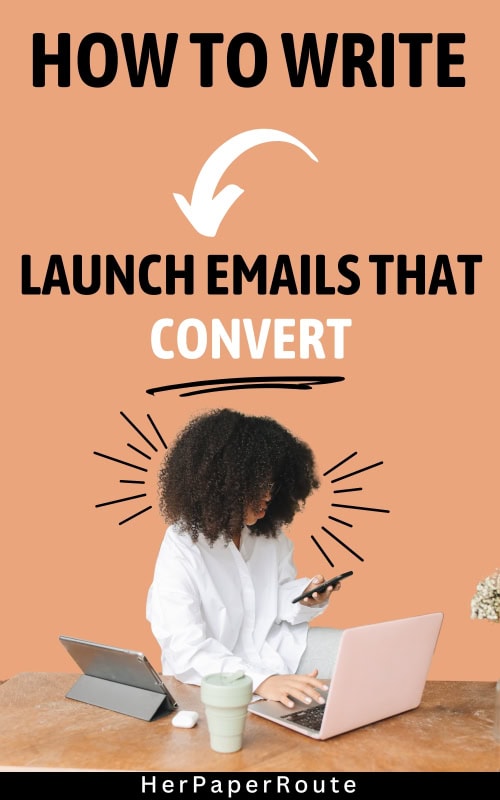
Follow along on Instagram!


